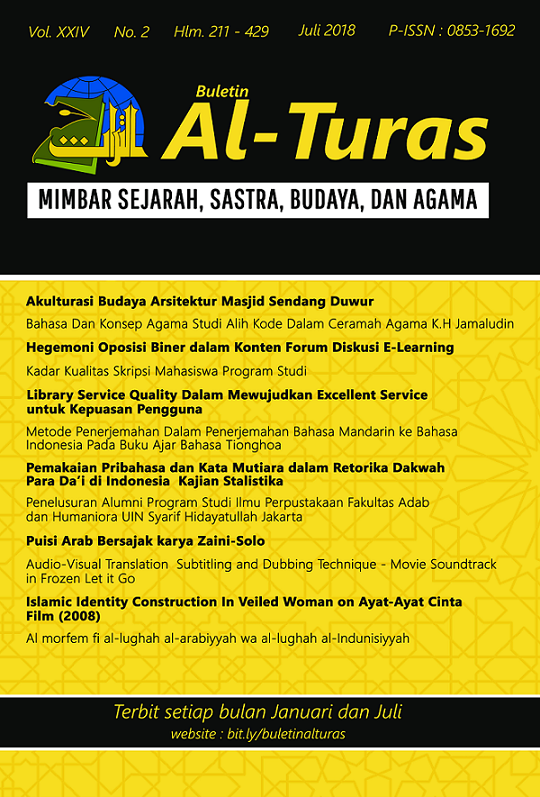The Love and Belonging Needs Character in The Girl on The Trains Novel
DOI:
https://doi.org/10.15408/bat.v25i1.10071Keywords:
Abraham Maslow, Character, Love and Belonging Needs, The Girl on The Train NovelAbstract
This research aims to understand what needs that Rachel Watson as the main character in The Girl on the Train novel is trying to fulfill by riding the train every day and how she fulfills her safety and the love and belonging needs using Abraham Maslow’s hierarchy of human needs. Before studying the needs, the writer analyzes the main character’s character and characterization. This research is using qualitative method and descriptive analysis to analyze the love and belonging needs and esteem needs of the main character. The result of this research is Rachel Watson as the main character has some noticeable characters such as imaginative, alcoholic, and liar. She fulfills her safety needs by killing her ex-husband and fulfills her love and belonging needs by trying to seek attention from her ex-husband, Tom Watson and from Scott Hipwell. Rachel fails to have the love from both Tom and Scott but finally she realizes that she is always loved by her friend, Cathy. Rachel successfully satisfies her needs until the third stage of the hierarchy: love and belonging needs.
References
Arndt, Jr., William B. (1974). Theories of Personality, New York: Macmillan Publishing Co., Inc,.
Bajekal, Naina. The Girl on The Train: The London Commute that Gripped Millions Moves to New York (2016, September 19). Newsweek. Retrieved from www.newsweek.com
Beaty, Jerome et al. (2006). The Norton Introduction to Education. New York: W.W. Norton Company.
Bennett, Andrew and Nicholas Royle. (2004). Introduction to Literature, Criticism and Theory. Harlow: Pearson Longman.
Boeree, George C. (2006). Personality Theories. Psychology Department Shippensburg University.
Colman, Andrew M. (2015). A Dictionary of Psychology. Oxford: Oxford University Press.
DiYanni, Robert. (2002). Literature. Reading Fiction, Poetry, and Drama. New York: McGrawHill.
Drinkaware. (n.d.). Retrieved Nov 9, 2017 from Drinkaware website: http://www.drinakaware.co.uk
Haifa, Nurul. (2015). A Main Character Analysis of “Ralph” in Wreck-it Ralph Film Using Hierarchy of Human Needs by Abraham H. Maslow. (Bachelor’s thesis). Universitas Islam Negeri Syarif Hidayatullah, Jakarta, Indonesia.
Harper, Frederick D. & Guilbault, Michael. (2008). Maslow’s Hierarchy of Basic Needs. Encyclopedia of Educational Psychology. (pp. 633-639). California: Sage Publications.
Hawkins, Paula. (2015). The Girl on the Train. New York: Riverhead Books.
Idrus, Muhammad. (2009). Metode Penelitian Ilmu Sosial. Pendekaran Kualitatif dan Kuantitatif. Jakarta: Erlangga.
Kowalski, Robin and Drew Westen. (2009). Psychology Fifth Edition. New Jersey: John Wiley & Sons, Inc.
Larsen, Rand and David M. Buss. (2008). Personality Psychology: Domains of Knowledge about Human Nature. New York: McGraw-Hill.
Maslow, Abraham H. (1943). A Theory of Human Motivation. Psychological Review. 50.4. 370-396.
Maslow, Abraham H. (1993). Motivasi dan Kepribadian-1. Translated by Nurul Imam. Bandung: PT Remaja Rosdakarya Offset.
Maslow, Abraham H. (1954). Motivation and Personality. New York: Harper & Row, Publishers, Inc.
Nandia, Rizqi. (2016). The Main Character Analysis on The Bling Ring Film Using Hierarchy of Human Needs Theory by Abraham Harold Maslow (Bachelor’s thesis). Universitas Islam Negeri Syarif Hidayatullah, Jakarta, Indonesia.
Nugrahini, Kartika Nurul. (2014). Kepribadian dan Aktualisasi Diri Tokoh Utama dalam Novel Supernova Episode Partikel Karya Dewi Lestari (Tinjauan Psikologi Sastra) (Bachelor’s thesis, Universitas Negeri Yogyakarta, Yogyakarta, Indonesia). Retrieved from eprints.uny.ac.id/17273
Penguin Random House Canada. (n.d.). Retrieved Dec 30, 2016 from Penguin Random House Canada website: https: penguinrandomhouse.ca
Poston, Bob. (2009). An Exercise in Personal Exploration: Maslow’s Hierarchy of Needs. The Surgical Technologist. 41.8. 347-353. Retrieved from www.ast.org/pdf/308.pdf
Prasetyo, Asep. (2017). A Main Character Analysis of Brooklyn Film Using Hierarchy of Human Needs by Abraham Maslow’s Psychology (Motivation) (Bachelor’s thesis). Universitas Islam Negeri Syarif Hidayatullah, Jakarta, Indonesia.
Riondita, Deby. (2017). Aktualisasi Diri Tokoh Utama Dalam Novel 1Q84 Karya Murakami Haruki (Bachelor’s thesis, Universitas Diponegoro, Semarang, Indonesia). Retrieved from eprints.undip.ac.id/58725/1/SKRIPSI_FULL.pdf
Rustin, Susanna. Paula Hawkins: The Woman behind The Girl on the Train (2016, April 29). The Guardian. Retrieved from www.theguardian.com
Santrock, John W. (2005). Psychology. New York: McGraw Hill.
Schultz, Duane P. & Schultz, Sydney Ellen. (2005). Theories of Personality. New York: Wadsworth.
Setiawan, Hendro. (2014). Manusia Utuh. Sleman: PT Kanisius.
Wahyuni, Sari. (2012). Qualitative Research Method. Theory and Practice. Jakarta: Salemba Empat.







